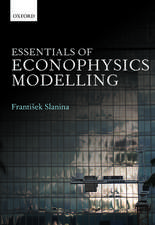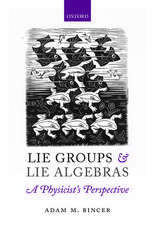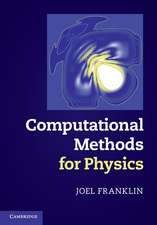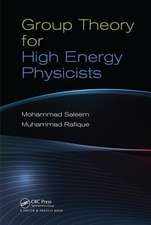Theory and Applications of the Poincaré Group: Fundamental Theories of Physics, cartea 17
Autor Young Suh Kim, M. Nozen Limba Engleză Hardback – 30 apr 1986
| Toate formatele și edițiile | Preț | Express |
|---|---|---|
| Paperback (1) | 947.18 lei 6-8 săpt. | |
| SPRINGER NETHERLANDS – 20 sep 2011 | 947.18 lei 6-8 săpt. | |
| Hardback (1) | 954.14 lei 6-8 săpt. | |
| SPRINGER NETHERLANDS – 30 apr 1986 | 954.14 lei 6-8 săpt. |
Din seria Fundamental Theories of Physics
- 20%
 Preț: 1002.39 lei
Preț: 1002.39 lei -
 Preț: 426.56 lei
Preț: 426.56 lei - 20%
 Preț: 819.51 lei
Preț: 819.51 lei - 18%
 Preț: 779.26 lei
Preț: 779.26 lei - 18%
 Preț: 955.25 lei
Preț: 955.25 lei - 18%
 Preț: 950.52 lei
Preț: 950.52 lei - 24%
 Preț: 794.91 lei
Preț: 794.91 lei - 18%
 Preț: 948.47 lei
Preț: 948.47 lei - 15%
 Preț: 589.80 lei
Preț: 589.80 lei - 18%
 Preț: 1229.73 lei
Preț: 1229.73 lei - 15%
 Preț: 587.83 lei
Preț: 587.83 lei - 18%
 Preț: 1236.06 lei
Preț: 1236.06 lei - 18%
 Preț: 946.87 lei
Preț: 946.87 lei -
 Preț: 394.87 lei
Preț: 394.87 lei - 18%
 Preț: 954.93 lei
Preț: 954.93 lei - 18%
 Preț: 1241.10 lei
Preț: 1241.10 lei - 18%
 Preț: 954.93 lei
Preț: 954.93 lei - 18%
 Preț: 953.35 lei
Preț: 953.35 lei - 18%
 Preț: 948.92 lei
Preț: 948.92 lei - 15%
 Preț: 648.05 lei
Preț: 648.05 lei - 18%
 Preț: 1232.09 lei
Preț: 1232.09 lei - 18%
 Preț: 996.78 lei
Preț: 996.78 lei - 18%
 Preț: 946.41 lei
Preț: 946.41 lei - 15%
 Preț: 640.24 lei
Preț: 640.24 lei - 15%
 Preț: 636.80 lei
Preț: 636.80 lei -
 Preț: 391.79 lei
Preț: 391.79 lei - 18%
 Preț: 780.19 lei
Preț: 780.19 lei -
 Preț: 391.79 lei
Preț: 391.79 lei - 15%
 Preț: 649.06 lei
Preț: 649.06 lei -
 Preț: 397.76 lei
Preț: 397.76 lei - 24%
 Preț: 586.71 lei
Preț: 586.71 lei - 15%
 Preț: 644.95 lei
Preț: 644.95 lei - 18%
 Preț: 1228.15 lei
Preț: 1228.15 lei
Preț: 954.14 lei
Preț vechi: 1163.58 lei
-18% Nou
Puncte Express: 1431
Preț estimativ în valută:
182.58€ • 195.24$ • 152.23£
182.58€ • 195.24$ • 152.23£
Carte tipărită la comandă
Livrare economică 18 aprilie-02 mai
Preluare comenzi: 021 569.72.76
Specificații
ISBN-13: 9789027721419
ISBN-10: 9027721416
Pagini: 352
Ilustrații: XV, 331 p.
Dimensiuni: 210 x 297 x 24 mm
Greutate: 0.69 kg
Ediția:1986
Editura: SPRINGER NETHERLANDS
Colecția Springer
Seria Fundamental Theories of Physics
Locul publicării:Dordrecht, Netherlands
ISBN-10: 9027721416
Pagini: 352
Ilustrații: XV, 331 p.
Dimensiuni: 210 x 297 x 24 mm
Greutate: 0.69 kg
Ediția:1986
Editura: SPRINGER NETHERLANDS
Colecția Springer
Seria Fundamental Theories of Physics
Locul publicării:Dordrecht, Netherlands
Public țintă
ResearchCuprins
I: Elements of Group Theory.- 1. Definition of a Group.- 2. Subgroups, Cosets, and Invariant Subgroups.- 3. Equivalence Classes, Orbits, and Little Groups.- 4. Representations and Representation Spaces.- 5. Properties of Matrices.- 6. Schur’s Lemma.- 7. Exercises and Problems.- II: Lie Groups and Lie Algebras.- 1. Basic Concepts of Lie Groups.- 2. Basic Theorems Concerning Lie Groups.- 3. Properties of Lie Algebras.- 4. Properties of Lie Groups.- 5. Further Theorems of Lie Groups.- 6. Exercises and Problems.- III: Theory of the Poincaré Group.- 1. Group of Lorentz Transformations.- 2. Orbits and Little Groups of the Proper Lorentz Group.- 3. Representations of the Poincaré Group.- 4. Lorentz Transformations of Wave Functions.- 5. Lorentz Transformations of Free Fields.- 6. Discrete Symmetry Operations.- 7. Exercises and Problems.- IV: Theory of Spinors.- 1. SL(2, c) as the Covering Group of the Lorentz Group.- 2. Subgroups of SL(2, c).- 3. SU (2).- 4. 5L(2, c) Spinors and Four-Vectors.- 5. Symmetries of the Dirac Equation.- 6. Exercises and Problems.- V: Covariant Harmonic Oscillator Formalism.- 1. Covariant Harmonic Oscillator Differential Equations.- 2. Normalizable Solutions of the Relativistic Oscillator Equation.- 3. Irreducible Unitary Representations of the Poincaré Group.- 4. Transformation Properties of Harmonic Oscillator Wave Functions.- 5. Harmonic Oscillators in the Four-Dimensional Euclidean Space.- 6. Moving O(4) Coordinate System.- 7. Exercises and Problems.- VI: Dirac’s Form of Relativistic Quantum Mechanics.- 1. C-Number Time-Energy Uncertainty Relation.- 2. Dirac’s Form of Relativistic Theory of “Atom ”.- 3. Dirac’s Light-Cone Coordinate System.- 4. Harmonic Oscillators in the Light-Cone Coordinate System.- 5. Lorentz-InvariantUncertainty Relations.- 6. Exercises and Problems.- VII: Massless Particles.- 1. What is the E(2) Group?.- 2. E(2)-like Little Group for Photons.- 3. Transformation Properties of Photon Polarization Vectors.- 4. Unitary Transformation of Photon Polarization Vectors.- 5. Massless Particles with Spin 1/2.- 6. Harmonic Oscillator Wave Functions for Massless Composite Particles.- 7. Exercises and Problems.- VIII: Group Contractions.- 1. SE(2) Group as a Contraction of SO(3).- 2. E(2)-like Little Group as an Infinite-momentum/zero-mass Limit of the O(3)-like Little Group for Massive Particles.- 3. Large-momentum/zero-mass Limit of the Dirac Equation.- 4. Finite-dimensional Non-unitary Representations of the SE(2) Group.- 5. Polarization Vectors for Massless Particles with Integer Spin.- 6. Lorentz and Galilei Transformations.- 7. Group Contractions and Unitary Representations of SE(2).- 8. Exercises and Problems.- IX: SO(2, 1) and SU(1, 1).- 1. Geometry of SL(2, r) and Sp(2).- 2. Finite-dimensional Representations of SO(2, 1).- 3. Complex Angular Momentum.- 4. Unitary Representations of SU(1, 1).- 5. Exercises and Problems.- X: Homogeneous Lorentz Group.- 1. Statement of the Problem.- 2. Finite-dimensional Representations of the Homogeneous Lorentz Group.- 3. Transformation Properties of Electric and Magnetic Fields.- 4. Pseudo-unitary Representations for Dirac Spinors.- 5. Harmonic Oscillator Wave Functions in the Lorentz Coordinate System.- 6. Further Properties of the Homogeneous Lorentz Group.- 7. Concluding Remarks.- XI: Hadronic Mass Spectra.- 1. Quark Model.- 2. Three-particle Symmetry Classifications According to the Method of Dirac.- 3. Construction of Symmetrized Wave Functions.- 4. Symmetrized Products of Symmetrized Wave Functions.- 5. Spin Wave Functions for the Three-Quark System.- 6. Three-quark Unitary Spin and SU(6) Wave Functions.- 7. Three-body Spatial Wave Functions.- 8. Totally Symmetric Baryonic Wave Functions.- 9. Baryonic Mass Spectra.- 10. Mesons.- 11. Exercises and Problems.- XII: Lorentz-Dirac Deformation in High-Energy Physics.- 1. Lorentz-Dirac Deformation of Hadronic Wave Functions.- 2. Form Factors of Nucléons.- 3. Calculation of the Form Factors.- 4. Scaling Phenomenon and the Parton Picture.- 5. Covariant Harmonic Oscillators and the Parton Picture.- 6. Calculation of the Parton Distribution Function for the Proton.- 7. Jet Phenomenon.- 8. Exercises and Problems.- References.















